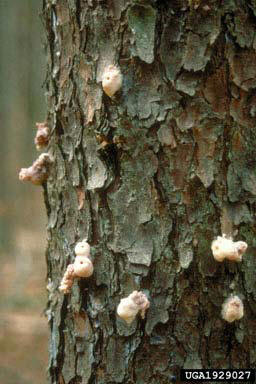
Southern pine bark beetles cause more damage to southern pine timber than any other forest insect in Alabama. On average, the state loses 60,000 pine trees a year during a southern pine bark beetle outbreak that totals approximately $800,000 in economic loss. Of course, during an epidemic episode, the amount of economic and timber loss is greatly increased.
Southern pine bark beetles generally attack less vigorous or stressed pines, especially ones weakened by a continual drought, storm damage, strong winds, severe fires, old age, prevailing diseases, tree competition, and other insect infestations. Most southern pine species, if not all are vulnerable, but depending on the particular beetle, some pines are more susceptible than others.
With three groups of southern pine bark beetles in the southeast wreaking havoc on pine trees; each one has its own distinguishable features and characteristics. The three groups of southern pine bark beetles are the southern pine beetle (SPB), the Ips engraver beetle (IEB), and the black turpentine beetle (BTB). Each beetle will initiate an attack based on specific causes and each will basically attack a different area of the tree. Even its rate of spread to the next pine is scantly different based on the beetle species.
Of the three, the SPB is the most aggressive and more likely to attack healthy pines. The IEB and the BTB tend to only attack weakened, stressed, or damaged trees. The IEB and BTB, however, have a slightly greater host list than the SPB. The SPB generally does not attack slash or longleaf pines unless these pine species are extremely stressed.
Management recommendations and control methods for these southern pine bark beetles are also quite specific depending on the particular beetle. The bark beetle species must be positively identified before implementing a control strategy. One constant prevention method that applies for all southern pine bark beetles is to maintain healthy, vigorous trees. In all, healthy, vigorous pines are the most successful management strategy for preventing bark beetle attack.
Biology and Prevention
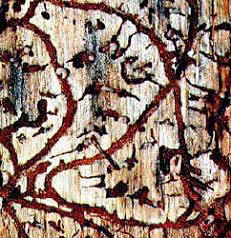
Host: All species of pine, but prefer loblolly,shortleaf, Virginia, pond and pitch pines.
Importance: The southern pine beetle (Dendroctonus frontalis) is the most destructive forest insect in the South. Weakening of trees by flooding, windstorms, and especially drought commonly precedes outbreaks. Trees of all sizes are attacked, but usually trees larger than six inches in diameter are infested first.
Identification: The brown to black beetle is about 1/8 inch long. Its hind end is rounded, in contrast to the scooped out posterior of the Ips beetle. Larvae are white with a reddish-brown head and the pupae pure white. Fully-grown larvae and pupae are approximately 1/8 inch in length. Eggs are white, and easily visible to the eye.
Signs of Attack: The first indication of attack is usually yellowing or browning of needles. The trunk will usually reveal white, yellow or sometimes red-brown pitch tubes, about as large as a wad of gum. Under drought conditions, pitch tubes may be very small or absent, and only reddish-brown boring dust will be present. Removal of the bark will show a distinctive winding "S" shaped gallery pattern. This pattern is quite different from the "Y" or "H" shaped gallery patterns of the Ips beetle and is a good identification characteristic. In active spots, trees in the center have dark reddish-brown foliage. Foliage will change to light greenish or yellowish green on the edges of active spots.
Life Cycle: Adult beetles are usually attracted to weakened trees. In epidemics, they attack trees that appear healthy and vigorous. Initial attacks are in the mid-trunk and then the length of the tree. Adult beetles bore through the bark and excavate long winding "S" shaped galleries. Eggs are laid in niches along the galleries. Larvae feed in the cambium until grown, and then excavate cells near the bark surface in which to pupate. After pupation, adult beetles chew through the bark and emerge. The complete cycle of the attack takes from 25 to 40 days, depending on the temperature.
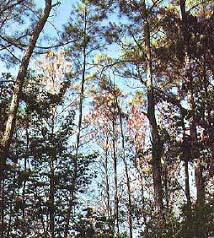
Control: Research has led to a better understanding of the beetle and its relationship to the tree and the stand. With this information, we can prevent beetle attack or more effectively manage an outbreak. The goal of an SPB prevention program is to identify pine stands growing under conditions preferred by the beetle. High hazard stands should be managed to favor vigorous tree growth and promote natural resistance to beetles. Red-topped pines in SPB spotTo rate a pine stand for SPB hazard, obtain information on pine basal area, total basal area, stand age and site index. This information is taken at each plot, with plots generally five chains apart (each plot represents approximately 2.5 acres) and put into a formula to determine the score associated with a hazard class. The following formula determines SPB hazard for a stand.
Score = 1.8342 (Pine BA) + 0.4085 (Total BA) + 0.705 (Age) + 0.88 (Site Index) - 206.315
| 220 or Above |
Very High |
| 168 to 219 |
High |
| 62 to 167 |
Medium |
| 11 to 61 |
Low |
| 10 to 0 |
Very Low |
Example: If total basal area is 130 sq. ft./acre, pine basal area is 120 sq. ft./acre, stand age is 27 years,and site index is 109.
Score = (1.8342 x 120) + (0.4085 x 130) + (0.705 x 27) +(0.88 x 109) - 206.315 = 181.85
The score of 181.85 is between 168 to 219 means the relative hazard rating is "High."
To reduce SPB losses in pine stands rated as medium or high hazard, consult a registered forester for management advice. Depending on the stand, the forester may recommend one or more of the following actions:
- Thin to basal areas of 70-100 sq. ft./acre to promote rapid tree growth and resistance to beetles.
- On sandy soils, use borax on tree stumps to prevent annosus root rot.
- Harvest and regenerate over-mature stands.
- Conduct a prescribed burn to reduce plant competition.
- Treat unwanted hardwoods in the pine stand with herbicide to reduce competition.
- When practical, remove high hazard trees preferred by beetles, e.g., those damaged by lightning, ice, logging or other pests.
Photo Credits: A Field Guide for Ground Checking Southern Pine Beetle Spots, Handbook No. 558, Tim Tigner, Virginia Department of Forestry, www.forestryimages.org, and Wes Nettleton, USFS, Region 8
Additional Beetle Control Information
Suppression is accomplished by an integrated approach in which three recommended techniques are involved. Emphasis is placed on control by timely removal and utilization of merchantable infested material. Unmerchantable material (small trees, infested bark, infested tops, etc.) should be either piled and burned or, as a last resort, chemically treated. Control efforts should be a year-round project; although, winter control is particularly important because brood densities tend to be higher and concentrated in a fewer number of trees. Research has indicated that control of one infested tree during the winter months may prevent 10 trees from becoming infested the following spring.
- Removal of Infested Trees by Salvage.
When infestations occur in trees of merchantable size and are readily accessible, infested trees should be removed. Because time is of the essence, logging of the infested material should begin IMMEDIATELY. To minimize the possibility of spreading beetle infestations, prompt processing of infested material at nearby mills is recommended. Slabs and infested bark should be destroyed by chipping or burning. Encourage the infested logs to be used first. If the logs are going to lay on the log deck for several days, spray the logs. Success in southern pine beetle salvage control hinges upon removing all pines with fresh attacks and those with developing beetle broods. The best insurance is to cut a buffer strip of uninfested green pines around the active head of a spreading spot. This tactic interrupts the beetles' attractant source and stops their advance. The buffer strip also provides a margin of error, just in case infested pines were initially overlooked.
- Width of Strip: The easiest rule is to make the width the same as the height of the infested trees. Example: The infested trees are 65-feet tall; cut the buffer to a width of 65-feet.
- Where to Start Making the Buffer: Start from the freshly attacked green pines and make the buffer from there into the green, healthy pines.
- Where to Start Cutting: Start with the outermost green pines and cut back towards the old, "dead," vacant pines (those are the ones with very loose bark which can be removed easily). There is no need to cut these "dead" trees. For effective control, cut only the green, freshly attacked pines and pines with developing broods. In the summer, these generally are the green, fading, and some of the red-topped trees.
- Piling and Burning
Cutting infested trees, piling the stems and thoroughly burning the bark surface may be used to suppress unmerchantable or inaccessible southern pine beetle infestations. The entire bark surface of infested trees must be thoroughly burned to insure effective control.
- Chemical Control - Use Only as a Last Resort.
For chemical to use contact a forester who is a Certified Pesticide Applicator.
Spray only spots that are inaccessible to salvage. Cut and buck all infested trees into workable lengths. Wet entire bark surface thoroughly (to the point of runoff) with a coarse spray from a low-pressure sprayer. Turn logs two or three times to insure all surface is wet.
Spray infested stumps or trees damaged by salvage crew. Cut and spray unmerchantable infested trees. Fell infested trees toward the center of the spot. Spray tops only if they are infested. Never spray trees from which beetle has emerged. This allows natural enemies to complete their development.
Habits: The adult beetles are usually attracted to weakened trees. In epidemics, however, they attack trees that appear to be healthy and vigorous. Initial beetle attacks are in the mid-trunk area and then up and down the length of the tree. The adult beetles bore through the bark and then excavate long winding "S" shaped galleries. Eggs are laid in niches along these galleries. The larvae feed in the cambium area until they are grown and then excavate cells in which to pupate near the bark surface. After pupation the adult beetles chew through the bark and emerge. The complete life cycle of the attack, takes from 25 to 40 days to complete, depending on the temperature.
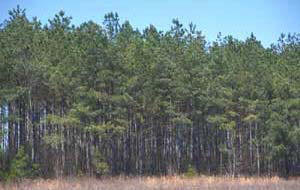
High SPB Hazard Stand
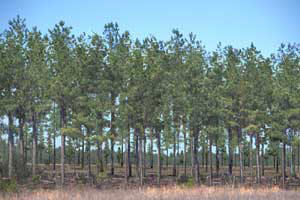
After Thinning High SPB Hazard Stand
Additional Resources